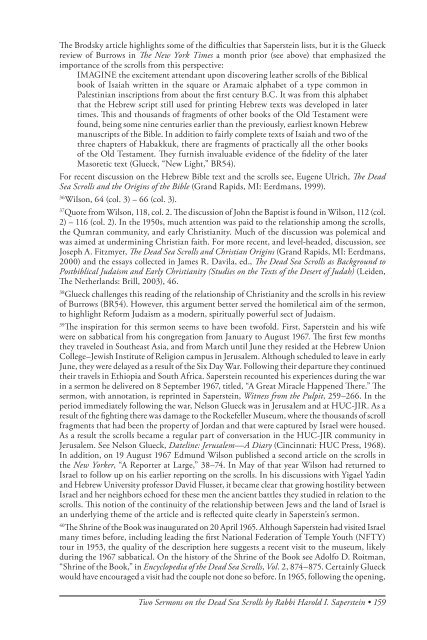The American Jewish Archives Journal, Volume LXI 2009, Number 1
The American Jewish Archives Journal, Volume LXI 2009, Number 1
The American Jewish Archives Journal, Volume LXI 2009, Number 1
Create successful ePaper yourself
Turn your PDF publications into a flip-book with our unique Google optimized e-Paper software.
<strong>The</strong> Brodsky article highlights some of the difficulties that Saperstein lists, but it is the Glueck<br />
review of Burrows in <strong>The</strong> New York Times a month prior (see above) that emphasized the<br />
importance of the scrolls from this perspective:<br />
IMAGINE the excitement attendant upon discovering leather scrolls of the Biblical<br />
book of Isaiah written in the square or Aramaic alphabet of a type common in<br />
Palestinian inscriptions from about the first century B.C. It was from this alphabet<br />
that the Hebrew script still used for printing Hebrew texts was developed in later<br />
times. This and thousands of fragments of other books of the Old Testament were<br />
found, being some nine centuries earlier than the previously, earliest known Hebrew<br />
manuscripts of the Bible. In addition to fairly complete texts of Isaiah and two of the<br />
three chapters of Habakkuk, there are fragments of practically all the other books<br />
of the Old Testament. <strong>The</strong>y furnish invaluable evidence of the fidelity of the later<br />
Masoretic text (Glueck, “New Light,” BR54).<br />
For recent discussion on the Hebrew Bible text and the scrolls see, Eugene Ulrich, <strong>The</strong> Dead<br />
Sea Scrolls and the Origins of the Bible (Grand Rapids, MI: Eerdmans, 1999).<br />
36 Wilson, 64 (col. 3) – 66 (col. 3).<br />
37 Quote from Wilson, 118, col. 2. <strong>The</strong> discussion of John the Baptist is found in Wilson, 112 (col.<br />
2) – 116 (col. 2). In the 1950s, much attention was paid to the relationship among the scrolls,<br />
the Qumran community, and early Christianity. Much of the discussion was polemical and<br />
was aimed at undermining Christian faith. For more recent, and level-headed, discussion, see<br />
Joseph A. Fitzmyer, <strong>The</strong> Dead Sea Scrolls and Christian Origins (Grand Rapids, MI: Eerdmans,<br />
2000) and the essays collected in James R. Davila, ed., <strong>The</strong> Dead Sea Scrolls as Background to<br />
Postbiblical Judaism and Early Christianity (Studies on the Texts of the Desert of Judah) (Leiden,<br />
<strong>The</strong> Netherlands: Brill, 2003), 46.<br />
38 Glueck challenges this reading of the relationship of Christianity and the scrolls in his review<br />
of Burrows (BR54). However, this argument better served the homiletical aim of the sermon,<br />
to highlight Reform Judaism as a modern, spiritually powerful sect of Judaism.<br />
39 <strong>The</strong> inspiration for this sermon seems to have been twofold. First, Saperstein and his wife<br />
were on sabbatical from his congregation from January to August 1967. <strong>The</strong> first few months<br />
they traveled in Southeast Asia, and from March until June they resided at the Hebrew Union<br />
College–<strong>Jewish</strong> Institute of Religion campus in Jerusalem. Although scheduled to leave in early<br />
June, they were delayed as a result of the Six Day War. Following their departure they continued<br />
their travels in Ethiopia and South Africa. Saperstein recounted his experiences during the war<br />
in a sermon he delivered on 8 September 1967, titled, “A Great Miracle Happened <strong>The</strong>re.” <strong>The</strong><br />
sermon, with annotation, is reprinted in Saperstein, Witness from the Pulpit, 259–266. In the<br />
period immediately following the war, Nelson Glueck was in Jerusalem and at HUC-JIR. As a<br />
result of the fighting there was damage to the Rockefeller Museum, where the thousands of scroll<br />
fragments that had been the property of Jordan and that were captured by Israel were housed.<br />
As a result the scrolls became a regular part of conversation in the HUC-JIR community in<br />
Jerusalem. See Nelson Glueck, Dateline: Jerusalem—A Diary (Cincinnati: HUC Press, 1968).<br />
In addition, on 19 August 1967 Edmund Wilson published a second article on the scrolls in<br />
the New Yorker, “A Reporter at Large,” 38–74. In May of that year Wilson had returned to<br />
Israel to follow up on his earlier reporting on the scrolls. In his discussions with Yigael Yadin<br />
and Hebrew University professor David Flusser, it became clear that growing hostility between<br />
Israel and her neighbors echoed for these men the ancient battles they studied in relation to the<br />
scrolls. This notion of the continuity of the relationship between Jews and the land of Israel is<br />
an underlying theme of the article and is reflected quite clearly in Saperstein’s sermon.<br />
40 <strong>The</strong> Shrine of the Book was inaugurated on 20 April 1965. Although Saperstein had visited Israel<br />
many times before, including leading the first National Federation of Temple Youth (NFTY)<br />
tour in 1953, the quality of the description here suggests a recent visit to the museum, likely<br />
during the 1967 sabbatical. On the history of the Shrine of the Book see Adolfo D. Roitman,<br />
“Shrine of the Book,” in Encyclopedia of the Dead Sea Scrolls, Vol. 2, 874–875. Certainly Glueck<br />
would have encouraged a visit had the couple not done so before. In 1965, following the opening,<br />
Two Sermons on the Dead Sea Scrolls by Rabbi Harold I. Saperstein • 159

















